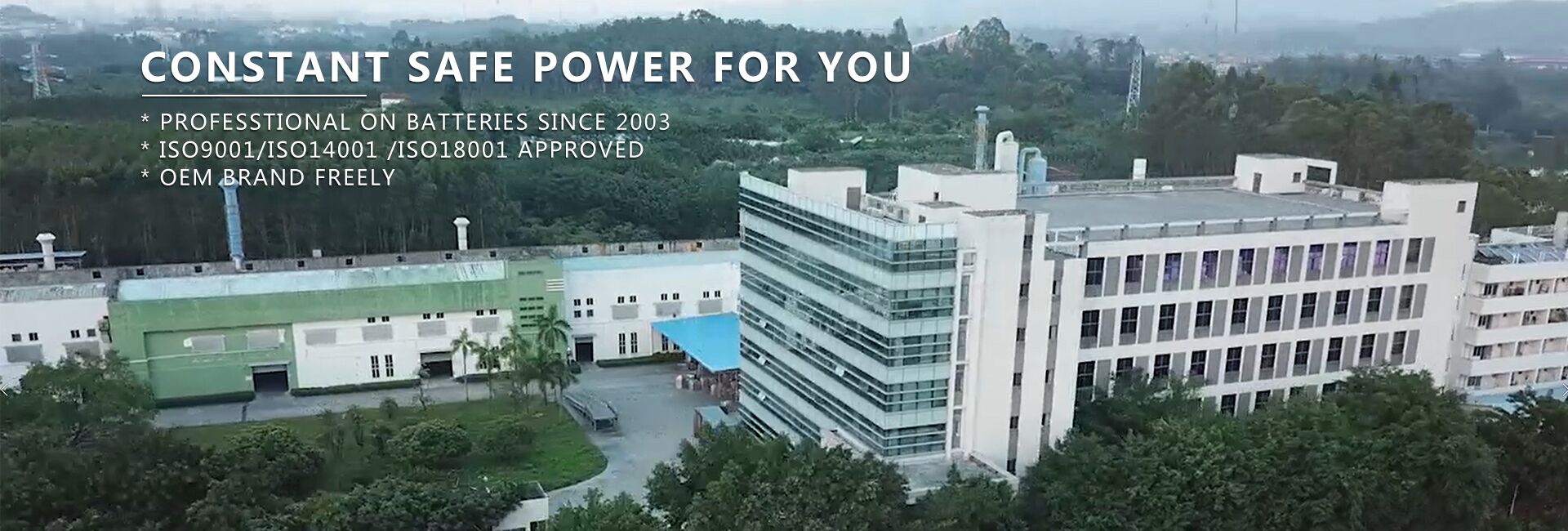എ: അതെ, ഞങ്ങൾ ചൈനയിലെ ഗ്വാങ്ഡോങ് പ്രവിശ്യയിലെ ഒരു പ്രൊഫഷണൽ ബാറ്ററി നിർമ്മാതാക്കളാണ്. ഞങ്ങൾ സ്വയം പ്ലേറ്റുകൾ നിർമ്മിക്കുന്നു.
A: ISO 9001, ISO 14001, OHSAS 18001, CE, UL, IEC 61427,IEC 6096 ടെസ്റ്റ് റിപ്പോർട്ട്, ജെൽ സാങ്കേതികവിദ്യയ്ക്കും മറ്റ് ചൈനീസ് ബഹുമതികൾക്കും പേറ്റന്റ്.
അതെ,OEM ബ്രാൻഡ് സ്വതന്ത്രമാണ്
എ: അതെ, ഓരോ മോഡലും 200PCS വരെ എത്തുന്നു, ഏത് കേസ് നിറവും സ്വതന്ത്രമായി ഇഷ്ടാനുസൃതമാക്കുക.
എ: സ്റ്റോക്ക് ഉൽപ്പന്നങ്ങൾക്ക് ഏകദേശം 7 ദിവസം, ഏകദേശം 25-35 ദിവസം ബൾക്ക് ഓർഡർ, 20 അടി ഫുൾ കണ്ടെയ്നർ ഉൽപ്പന്നങ്ങൾ.
A: ഗുണനിലവാരം നിയന്ത്രിക്കുന്നതിന് ഞങ്ങൾ ISO 9001 ഗുണനിലവാര സംവിധാനം സ്വീകരിക്കുന്നു. അസംസ്കൃത വസ്തുക്കൾ ഉയർന്ന നിലവാരമുള്ള ഉൽപാദന ആവശ്യകതകൾ പാലിക്കുന്നുണ്ടെന്ന് പരിശോധിക്കുന്നതിനും സ്ഥിരീകരിക്കുന്നതിനും ഞങ്ങൾക്ക് ഇൻകമിംഗ് ക്വാളിറ്റി കൺട്രോൾ (IQC) വകുപ്പ് ഉണ്ട്, പ്രൊഡക്ഷൻ ക്വാളിറ്റി കൺട്രോൾ (PQC) വകുപ്പിൽ ആദ്യത്തെ പരിശോധന, ഇൻ-പ്രോസസ് ഗുണനിലവാര നിയന്ത്രണം, സ്വീകാര്യത പരിശോധന, പൂർണ്ണ പരിശോധന, ഔട്ട്ഗോയിംഗ് ക്വാളിറ്റി കൺട്രോൾ (OQC) വകുപ്പ് ഫാക്ടറിയിൽ നിന്ന് തകരാറുള്ള ബാറ്ററികളൊന്നും പുറത്തുവരുന്നില്ലെന്ന് സ്ഥിരീകരിക്കുന്നു.
എ: അതെ, ഞങ്ങളുടെ ബാറ്ററികൾ കടൽ വഴിയും വായുമാർഗ്ഗവും എത്തിക്കാൻ കഴിയും. അപകടകരമല്ലാത്ത ഉൽപ്പന്നങ്ങളായി സുരക്ഷിത ഗതാഗതത്തിനായുള്ള MSDS, ടെസ്റ്റ് റിപ്പോർട്ട് ഞങ്ങളുടെ പക്കലുണ്ട്.
A: ഇത് ബാറ്ററി ശേഷി, ഡിസ്ചാർജിന്റെ ആഴം, ബാറ്ററി ഉപയോഗം എന്നിവയെ ആശ്രയിച്ചിരിക്കുന്നു. വിശദമായ ആവശ്യകതകളെ അടിസ്ഥാനമാക്കിയുള്ള കൃത്യമായ വിവരങ്ങൾക്ക് ദയവായി ഞങ്ങളെ ബന്ധപ്പെടുക.
"നിങ്ങൾക്ക് ഒരു 3 സ്റ്റേജ് ചാർജർ ആവശ്യമാണ്" എന്ന് പറയുന്നത് നിങ്ങൾ കേട്ടിരിക്കാം. ഞങ്ങൾ അത് പറഞ്ഞു കഴിഞ്ഞു, വീണ്ടും പറയാം. നിങ്ങളുടെ ബാറ്ററിയിൽ ഉപയോഗിക്കാൻ ഏറ്റവും നല്ല ചാർജർ 3 സ്റ്റേജ് ചാർജറാണ്. അവയെ "സ്മാർട്ട് ചാർജറുകൾ" അല്ലെങ്കിൽ "മൈക്രോ പ്രോസസർ നിയന്ത്രിത ചാർജറുകൾ" എന്നും വിളിക്കുന്നു. അടിസ്ഥാനപരമായി, ഈ തരത്തിലുള്ള ചാർജറുകൾ സുരക്ഷിതവും ഉപയോഗിക്കാൻ എളുപ്പവുമാണ്, കൂടാതെ നിങ്ങളുടെ ബാറ്ററി അമിതമായി ചാർജ് ചെയ്യില്ല. ഞങ്ങൾ വിൽക്കുന്ന മിക്കവാറും എല്ലാ ചാർജറുകളും 3 സ്റ്റേജ് ചാർജറുകളാണ്. ശരി, അതിനാൽ 3 സ്റ്റേജ് ചാർജറുകൾ പ്രവർത്തിക്കുന്നുവെന്നും അവ നന്നായി പ്രവർത്തിക്കുന്നുവെന്നും നിഷേധിക്കാൻ പ്രയാസമാണ്. എന്നാൽ ഇതാ ദശലക്ഷം ഡോളർ ചോദ്യം: 3 ഘട്ടങ്ങൾ എന്തൊക്കെയാണ്? ഈ ചാർജറുകളെ ഇത്ര വ്യത്യസ്തവും കാര്യക്ഷമവുമാക്കുന്നത് എന്താണ്? ഇത് ശരിക്കും വിലമതിക്കുന്നുണ്ടോ? ഓരോ ഘട്ടത്തിലൂടെയും ഓരോന്നായി കടന്നുപോകുന്നതിലൂടെ നമുക്ക് അത് കണ്ടെത്താം:
ഘട്ടം 1 | ബൾക്ക് ചാർജ്
ഒരു ബാറ്ററി ചാർജറിന്റെ പ്രാഥമിക ലക്ഷ്യം ബാറ്ററി റീചാർജ് ചെയ്യുക എന്നതാണ്. ഈ ആദ്യ ഘട്ടത്തിൽ സാധാരണയായി ചാർജർ റേറ്റുചെയ്തിരിക്കുന്ന ഏറ്റവും ഉയർന്ന വോൾട്ടേജും ആമ്പിയേജും ഉപയോഗിക്കും. ബാറ്ററി അമിതമായി ചൂടാക്കാതെ പ്രയോഗിക്കാൻ കഴിയുന്ന ചാർജിന്റെ അളവ് ബാറ്ററിയുടെ സ്വാഭാവിക ആഗിരണം നിരക്ക് എന്നറിയപ്പെടുന്നു. ഒരു സാധാരണ 12 വോൾട്ട് AGM ബാറ്ററിയിൽ, ബാറ്ററിയിലേക്ക് പോകുന്ന ചാർജിംഗ് വോൾട്ടേജ് 14.6-14.8 വോൾട്ടിൽ എത്തും, അതേസമയം ഫ്ലഡ് ചെയ്ത ബാറ്ററികൾ ഇതിലും കൂടുതലാകാം. ജെൽ ബാറ്ററിയിൽ, വോൾട്ടേജ് 14.2-14.3 വോൾട്ടിൽ കൂടരുത്. ചാർജർ 10 ആംപ് ചാർജറാണെങ്കിൽ, ബാറ്ററി പ്രതിരോധം അതിന് അനുവദിക്കുകയാണെങ്കിൽ, ചാർജർ പൂർണ്ണമായി 10 ആമ്പുകൾ പുറപ്പെടുവിക്കും. ഈ ഘട്ടത്തിൽ ഗുരുതരമായി തീർന്ന ബാറ്ററികൾ റീചാർജ് ചെയ്യും. ബാറ്ററി ഇതുവരെ പൂർണ്ണമായി എത്തിയിട്ടില്ലാത്തതിനാൽ ഈ ഘട്ടത്തിൽ അമിതമായി ചാർജ് ചെയ്യാനുള്ള സാധ്യതയില്ല.
ഘട്ടം 2 | അബ്സോർപ്ഷൻ ചാർജ്
സ്മാർട്ട് ചാർജറുകൾ ചാർജ് ചെയ്യുന്നതിന് മുമ്പ് ബാറ്ററിയിൽ നിന്നുള്ള വോൾട്ടേജും പ്രതിരോധവും കണ്ടെത്തും. ബാറ്ററി വായിച്ചതിനുശേഷം, ഏത് ഘട്ടത്തിലാണ് ശരിയായി ചാർജ് ചെയ്യേണ്ടതെന്ന് ചാർജർ നിർണ്ണയിക്കുന്നു. ബാറ്ററി 80%* ചാർജ് അവസ്ഥയിൽ എത്തിക്കഴിഞ്ഞാൽ, ചാർജർ ആഗിരണം ഘട്ടത്തിലേക്ക് പ്രവേശിക്കും. ഈ ഘട്ടത്തിൽ മിക്ക ചാർജറുകളും സ്ഥിരമായ വോൾട്ടേജ് നിലനിർത്തും, അതേസമയം ആമ്പിയേജ് കുറയുന്നു. ബാറ്ററിയിലേക്ക് പോകുന്ന കുറഞ്ഞ കറന്റ് ബാറ്ററിയെ അമിതമായി ചൂടാക്കാതെ സുരക്ഷിതമായി ചാർജ്ജ് വർദ്ധിപ്പിക്കുന്നു.
ഈ ഘട്ടം കൂടുതൽ സമയമെടുക്കും. ഉദാഹരണത്തിന്, ബൾക്ക് ഘട്ടത്തിൽ ആദ്യത്തെ 20% ചാർജ് ചെയ്യുന്നതിനേക്കാൾ ശേഷിക്കുന്ന ബാറ്ററിയുടെ അവസാന 20% ചാർജ് ചെയ്യാൻ കൂടുതൽ സമയമെടുക്കും. ബാറ്ററി പൂർണ്ണ ശേഷിയിൽ എത്തുന്നതുവരെ കറന്റ് തുടർച്ചയായി കുറയുന്നു.
*ചാർജിന്റെ യഥാർത്ഥ അവസ്ഥ അബ്സോർപ്ഷൻ ഘട്ടം പ്രവേശിക്കുമ്പോൾ ചാർജർ മുതൽ ചാർജർ വരെ വ്യത്യാസപ്പെടും.
ഘട്ടം 3 | ഫ്ലോട്ട് ചാർജ്
ചില ചാർജറുകൾ 85% ചാർജ്ജ് അവസ്ഥയിൽ തന്നെ ഫ്ലോട്ട് മോഡിലേക്ക് പ്രവേശിക്കും, എന്നാൽ മറ്റുള്ളവ 95% ത്തോട് അടുക്കാൻ തുടങ്ങും. എന്തായാലും, ഫ്ലോട്ട് ഘട്ടം ബാറ്ററിയെ പൂർണ്ണമായും ചാർജ്ജ് അവസ്ഥയിലേക്ക് കൊണ്ടുവരികയും 100% ചാർജ്ജ് അവസ്ഥ നിലനിർത്തുകയും ചെയ്യുന്നു. വോൾട്ടേജ് കുറയുകയും സ്ഥിരമായി 13.2-13.4 വോൾട്ടിൽ നിലനിർത്തുകയും ചെയ്യും, അതായത്12 വോൾട്ട് ബാറ്ററിക്ക് ഉൾക്കൊള്ളാൻ കഴിയുന്ന പരമാവധി വോൾട്ടേജ്. കറന്റ് ഒരു ട്രിക്കിൾ ആയി കണക്കാക്കുന്ന ഒരു ഘട്ടത്തിലേക്ക് കുറയുകയും ചെയ്യും. "ട്രിക്കിൾ ചാർജർ" എന്ന പദം വരുന്നത് അവിടെ നിന്നാണ്. അടിസ്ഥാനപരമായി ഇത് ഫ്ലോട്ട് ഘട്ടമാണ്, അവിടെ എല്ലായ്പ്പോഴും ബാറ്ററിയിലേക്ക് ചാർജ് പോകുന്നു, എന്നാൽ പൂർണ്ണമായ ചാർജ് അവസ്ഥ ഉറപ്പാക്കാൻ സുരക്ഷിതമായ നിരക്കിൽ മാത്രം, അതിൽ കൂടുതലൊന്നും ഇല്ല. മിക്ക സ്മാർട്ട് ചാർജറുകളും ഈ ഘട്ടത്തിൽ ഓഫാക്കില്ല, എന്നിരുന്നാലും ഒരു ബാറ്ററി മാസങ്ങൾ മുതൽ വർഷങ്ങൾ വരെ ഫ്ലോട്ട് മോഡിൽ വയ്ക്കുന്നത് പൂർണ്ണമായും സുരക്ഷിതമാണ്.
ഒരു ബാറ്ററിക്ക് ഏറ്റവും ആരോഗ്യകരമായ കാര്യം 100% ചാർജ്ജ് ആയ അവസ്ഥയിലായിരിക്കുക എന്നതാണ്.
നമ്മൾ ഇത് മുമ്പ് പറഞ്ഞിട്ടുണ്ട്, വീണ്ടും പറയാം. ബാറ്ററിയിൽ ഉപയോഗിക്കാൻ ഏറ്റവും മികച്ച ചാർജർ ഒരു3 ഘട്ട സ്മാർട്ട് ചാർജർ. അവ ഉപയോഗിക്കാൻ എളുപ്പമാണ്, വിഷമിക്കേണ്ടതില്ല. ചാർജർ ബാറ്ററിയിൽ കൂടുതൽ നേരം വച്ചിരിക്കുന്നതിനെക്കുറിച്ച് നിങ്ങൾ ഒരിക്കലും വിഷമിക്കേണ്ടതില്ല. വാസ്തവത്തിൽ, നിങ്ങൾ അത് ഓണാക്കി വയ്ക്കുന്നതാണ് നല്ലത്. ബാറ്ററി പൂർണ്ണമായി ചാർജ് ചെയ്തിട്ടില്ലാത്തപ്പോൾ, പ്ലേറ്റുകളിൽ സൾഫേറ്റ് ക്രിസ്റ്റലുകൾ അടിഞ്ഞുകൂടുകയും ഇത് നിങ്ങളുടെ പവർ കവർന്നെടുക്കുകയും ചെയ്യും. ഓഫ് സീസണിലോ അവധിക്കാലത്തോ നിങ്ങളുടെ പവർസ്പോർട്സ് ഷെഡിൽ ഉപേക്ഷിക്കുകയാണെങ്കിൽ, ദയവായി ബാറ്ററി ഒരു 3-സ്റ്റേജ് ചാർജറുമായി ബന്ധിപ്പിക്കുക. നിങ്ങൾ എപ്പോൾ വേണമെങ്കിലും നിങ്ങളുടെ ബാറ്ററി സ്റ്റാർട്ട് ചെയ്യാൻ തയ്യാറാകുമെന്ന് ഇത് ഉറപ്പാക്കും.
എ: ലെഡ് കാർബൺ ബാറ്ററി ഫാസ്റ്റ് ചാർജിംഗിനെ പിന്തുണയ്ക്കുന്നു. ലെഡ് കാർബൺ ബാറ്ററി ഒഴികെ, മറ്റ് മോഡലുകൾക്ക് ഫാസ്റ്റ് ചാർജിംഗ് ശുപാർശ ചെയ്യുന്നില്ല, കാരണം ഇത് ബാറ്ററിക്ക് ദോഷകരമാണ്.
VRLA ബാറ്ററികളെ സംബന്ധിച്ച്, നിങ്ങളുടെ ക്ലയന്റിനോ അന്തിമ ഉപയോക്താവിനോ ഉള്ള പ്രധാന അറ്റകുറ്റപ്പണി നുറുങ്ങുകൾ ചുവടെയുണ്ട്, കാരണം പതിവ് അറ്റകുറ്റപ്പണികൾ മാത്രമേ ഉപയോഗത്തിനിടയിലുള്ള വ്യക്തിഗത അസാധാരണ ബാറ്ററിയും മാനേജ്മെന്റ് സിസ്റ്റം പ്രശ്നവും കണ്ടെത്താൻ സഹായിക്കൂ, ഉപകരണങ്ങൾ തുടർച്ചയായും സുരക്ഷിതമായും പ്രവർത്തിക്കുന്നുവെന്ന് ഉറപ്പാക്കുന്നതിന് സമയബന്ധിതമായി ക്രമീകരിക്കുന്നതിനും ബാറ്ററി ആയുസ്സ് വർദ്ധിപ്പിക്കുന്നതിനും ഇത് സഹായിക്കും:
ദൈനംദിന അറ്റകുറ്റപ്പണികൾ:
1. ബാറ്ററി ഉപരിതലം വരണ്ടതും വൃത്തിയുള്ളതുമാണെന്ന് ഉറപ്പാക്കുക.
2. ബാറ്ററി വയറിംഗ് ടെർമിനൽ നന്നായി ബന്ധിപ്പിച്ചിട്ടുണ്ടെന്ന് ഉറപ്പാക്കുക.
3. മുറി വൃത്തിയുള്ളതും തണുപ്പുള്ളതുമാണെന്ന് ഉറപ്പാക്കുക (ഏകദേശം 25 ഡിഗ്രി).
4. ബാറ്ററി ഔട്ട്ലുക്ക് സാധാരണമാണോ എന്ന് പരിശോധിക്കുക.
5. ചാർജ് വോൾട്ടേജ് സാധാരണമാണെങ്കിൽ പരിശോധിക്കുക.
കൂടുതൽ ബാറ്ററി പരിപാലന നുറുങ്ങുകൾക്കായി എപ്പോൾ വേണമെങ്കിലും CSPOWER-നെ സമീപിക്കാം.
A:ബാറ്ററി ശേഷിയുടെ അപര്യാപ്തത മൂലമാണ് അമിതമായി ഡിസ്ചാർജ് ചെയ്യപ്പെടുന്നത്, ഇത് ബാറ്ററികൾ അമിതമായി പ്രവർത്തിക്കാൻ കാരണമാകും. 50% ൽ കൂടുതൽ ആഴത്തിൽ ഡിസ്ചാർജ് ചെയ്യപ്പെടുന്ന ഡിസ്ചാർജുകൾ (യഥാർത്ഥത്തിൽ 12.0 വോൾട്ട് അല്ലെങ്കിൽ 1.200 സ്പെസിഫിക് ഗ്രാവിറ്റിയിൽ വളരെ താഴെ) സൈക്കിളിന്റെ ഉപയോഗയോഗ്യമായ ആഴം വർദ്ധിപ്പിക്കാതെ ബാറ്ററിയുടെ സൈക്കിൾ ലൈഫിനെ ഗണ്യമായി കുറയ്ക്കുന്നു. അപൂർവ്വമായോ അപര്യാപ്തമായോ റീചാർജ് ചെയ്യുന്നത് സൾഫേഷൻ എന്നറിയപ്പെടുന്ന ഓവർ ഡിസ്ചാർജ് ലക്ഷണങ്ങൾക്ക് കാരണമാകും. ചാർജിംഗ് ഉപകരണങ്ങൾ ശരിയായി നിയന്ത്രിക്കുന്നുണ്ടെങ്കിലും, ഓവർ ഡിസ്ചാർജ് ചെയ്യുന്ന ലക്ഷണങ്ങൾ ബാറ്ററി ശേഷി നഷ്ടപ്പെടുകയും സാധാരണയേക്കാൾ കുറവായിരിക്കുകയും ചെയ്യുന്നു. ഇലക്ട്രോലൈറ്റിൽ നിന്നുള്ള സൾഫർ പ്ലേറ്റുകളിലെ ലെഡുമായി സംയോജിച്ച് ലെഡ്-സൾഫേറ്റ് രൂപപ്പെടുമ്പോൾ സൾഫേറ്റ് സംഭവിക്കുന്നു. ഈ അവസ്ഥ സംഭവിച്ചുകഴിഞ്ഞാൽ, മറൈൻ ബാറ്ററി ചാർജറുകൾ കഠിനമായ സൾഫേറ്റ് നീക്കം ചെയ്യില്ല. ബാഹ്യ മാനുവൽ ബാറ്ററി ചാർജറുകൾ ഉപയോഗിച്ച് ശരിയായ ഡീസൾഫേഷൻ അല്ലെങ്കിൽ ഇക്വലൈസേഷൻ ചാർജ് വഴി സൾഫേറ്റ് സാധാരണയായി നീക്കംചെയ്യാം. ഈ ദൗത്യം നിറവേറ്റുന്നതിന്, ഫ്ലഡ് ചെയ്ത പ്ലേറ്റ് ബാറ്ററികൾ 6 മുതൽ 10 ആമ്പിയർ വരെ ചാർജ് ചെയ്യണം. എല്ലാ സെല്ലുകളും സ്വതന്ത്രമായി വാതകം പുറപ്പെടുവിക്കുകയും അവയുടെ പ്രത്യേക ഗുരുത്വാകർഷണം അവയുടെ പൂർണ്ണ ചാർജ് സാന്ദ്രതയിലേക്ക് മടങ്ങുകയും ചെയ്യുന്നതുവരെ ഓരോ സെല്ലിനും 2.4 മുതൽ 2.5 വോൾട്ട് വരെ. സീൽ ചെയ്ത AGM ബാറ്ററികൾ ഓരോ സെല്ലിനും 2.35 വോൾട്ടിലേക്ക് കൊണ്ടുവരണം, തുടർന്ന് ഓരോ സെല്ലിനും 1.75 വോൾട്ടിലേക്ക് ഡിസ്ചാർജ് ചെയ്യണം, തുടർന്ന് ശേഷി ബാറ്ററിയിലേക്ക് തിരികെ വരുന്നതുവരെ ഈ പ്രക്രിയ ആവർത്തിക്കണം. ജെൽ ബാറ്ററികൾ വീണ്ടെടുക്കാൻ കഴിഞ്ഞേക്കില്ല. മിക്ക കേസുകളിലും, അതിന്റെ സേവന ജീവിതം പൂർത്തിയാക്കാൻ ബാറ്ററി തിരികെ നൽകാം.
ചാർജിംഗ് ആൾട്ടർനേറ്ററുകൾക്കും ഫ്ലോട്ട് ബാറ്ററി ചാർജറുകൾക്കും റെഗുലേറ്റഡ് ഫോട്ടോ വോൾട്ടായിക് ചാർജറുകൾ ഉൾപ്പെടെയുള്ളവയിൽ ഓട്ടോമാറ്റിക് നിയന്ത്രണങ്ങളുണ്ട്, ഇത് ബാറ്ററികൾ ചാർജ്ജ് ആകുമ്പോൾ ചാർജ് നിരക്ക് കുറയ്ക്കുന്നു. ചാർജ് ചെയ്യുമ്പോൾ കുറച്ച് ആമ്പിയറുകളായി കുറയുന്നത് ബാറ്ററികൾ പൂർണ്ണമായും ചാർജ്ജ് ചെയ്തുവെന്ന് അർത്ഥമാക്കുന്നില്ല എന്നത് ശ്രദ്ധിക്കേണ്ടതാണ്. ബാറ്ററി ചാർജറുകൾ മൂന്ന് തരത്തിലാണ്. മാനുവൽ തരം, ട്രിക്കിൾ തരം, ഓട്ടോമാറ്റിക് സ്വിച്ചർ തരം എന്നിവയുണ്ട്.
UPS VRLA ബാറ്ററി ആയതിനാൽ, ബാറ്ററി ഫ്ലോട്ട് ചാർജ് അവസ്ഥയിലാണ്, പക്ഷേ സങ്കീർണ്ണമായ ഊർജ്ജ മാറ്റം ഇപ്പോഴും ബാറ്ററിക്കുള്ളിൽ പ്രവർത്തിക്കുന്നു. ഫ്ലോട്ട് ചാർജ് സമയത്ത് വൈദ്യുതോർജ്ജം താപ ഊർജ്ജമായി മാറിയിരിക്കുന്നു, അതിനാൽ ബാറ്ററി വർക്ക് പരിതസ്ഥിതിക്ക് നല്ല താപ റിലീസ് ശേഷിയോ എയർ കണ്ടീഷണറോ ഉണ്ടായിരിക്കണമെന്ന് അഭ്യർത്ഥിക്കുക.
VRLA ബാറ്ററി വൃത്തിയുള്ളതും തണുത്തതും വായുസഞ്ചാരമുള്ളതും വരണ്ടതുമായ സ്ഥലത്ത് സ്ഥാപിക്കണം, സൂര്യപ്രകാശം, അമിത ചൂടാക്കൽ അല്ലെങ്കിൽ വികിരണ ചൂട് എന്നിവ ഏൽക്കുന്നത് ഒഴിവാക്കുക.
VRLA ബാറ്ററി 5 മുതൽ 35 ഡിഗ്രി വരെയുള്ള താപനിലയിൽ ചാർജ് ചെയ്യണം. താപനില 5 ഡിഗ്രിയിൽ താഴെയോ 35 ഡിഗ്രിയിൽ കൂടുതലോ ആകുമ്പോൾ ബാറ്ററി ലൈഫ് കുറയും. ചാർജ് വോൾട്ടേജ് അഭ്യർത്ഥന പരിധി കവിയാൻ പാടില്ല, അല്ലാത്തപക്ഷം, ബാറ്ററിക്ക് കേടുപാടുകൾ സംഭവിക്കുകയോ, ആയുസ്സ് കുറയുകയോ, ശേഷി കുറയുകയോ ചെയ്യും.
കർശനമായ ബാറ്ററി തിരഞ്ഞെടുക്കൽ നടപടിക്രമമുണ്ടെങ്കിലും, ഒരു നിശ്ചിത കാലയളവ് ഉപയോഗിക്കുമ്പോൾ, ഏകതാനതയില്ലായ്മ കൂടുതൽ കൂടുതൽ വ്യക്തമായി ദൃശ്യമാകും. അതേസമയം, ചാർജിംഗ് ഉപകരണങ്ങൾക്ക് ദുർബലമായ ബാറ്ററി തിരഞ്ഞെടുക്കാനും തിരിച്ചറിയാനും കഴിയില്ല, അതിനാൽ ബാറ്ററി ശേഷിയുടെ സന്തുലിതാവസ്ഥ എങ്ങനെ നിലനിർത്താമെന്ന് ഉപയോക്താവിന് നിയന്ത്രിക്കാൻ കഴിയും. ബാറ്ററി പായ്ക്ക് ഉപയോഗത്തിന്റെ മധ്യത്തിലും പിന്നീടുള്ള സമയത്തും ഉപയോക്താവ് ഓരോ ബാറ്ററിയുടെയും OCV പതിവായി അല്ലെങ്കിൽ ക്രമരഹിതമായി പരിശോധിക്കുകയും വോൾട്ടേജും ശേഷിയും മറ്റ് ബാറ്ററികളുടേതിന് തുല്യമാക്കുന്നതിന്, കുറഞ്ഞ വോൾട്ടേജുള്ള ബാറ്ററി വെവ്വേറെ റീചാർജ് ചെയ്യുകയും വേണം, ഇത് ബാറ്ററികൾ തമ്മിലുള്ള വ്യത്യാസം കുറയ്ക്കുന്നു.
A: സീൽ ചെയ്ത ലെഡ് ആസിഡ് ബാറ്ററിയുടെ ആയുസ്സ് പല ഘടകങ്ങളാൽ നിർണ്ണയിക്കപ്പെടുന്നു. താപനില, ആഴം, ഡിസ്ചാർജ് നിരക്ക്, ചാർജുകളുടെയും ഡിസ്ചാർജുകളുടെയും എണ്ണം (സൈക്കിളുകൾ എന്ന് വിളിക്കുന്നു) എന്നിവ ഇതിൽ ഉൾപ്പെടുന്നു.
ഫ്ലോട്ട്, സൈക്കിൾ ആപ്ലിക്കേഷനുകൾ തമ്മിലുള്ള വ്യത്യാസം എന്താണ്?
ഒരു ഫ്ലോട്ട് ആപ്ലിക്കേഷനിൽ ബാറ്ററി സ്ഥിരമായി ചാർജ് ചെയ്യേണ്ടതും ഇടയ്ക്കിടെ ഡിസ്ചാർജ് ചെയ്യേണ്ടതുമാണ്. സൈക്കിൾ ആപ്ലിക്കേഷനുകൾ പതിവായി ബാറ്ററി ചാർജ് ചെയ്യുകയും ഡിസ്ചാർജ് ചെയ്യുകയും ചെയ്യുന്നു.
A:ചില ഡിസ്ചാർജ് സാഹചര്യങ്ങളിൽ ബാറ്ററി അവസാന വോൾട്ടേജിൽ ഡിസ്ചാർജ് ചെയ്യുമ്പോൾ യഥാർത്ഥ പവറും നാമമാത്ര ശേഷിയും തമ്മിലുള്ള അനുപാതത്തെയാണ് ഡിസ്ചാർജ് കാര്യക്ഷമത എന്ന് പറയുന്നത്. ഡിസ്ചാർജ് നിരക്ക്, പരിസ്ഥിതി താപനില, ആന്തരിക പ്രതിരോധം തുടങ്ങിയ ഘടകങ്ങളാണ് ഇതിനെ പ്രധാനമായും ബാധിക്കുന്നത്. സാധാരണയായി, ഡിസ്ചാർജ് നിരക്ക് കൂടുന്തോറും ഡിസ്ചാർജ് കാര്യക്ഷമത കുറയും; താപനില കുറയുന്തോറും ഡിസ്ചാർജ് കാര്യക്ഷമത കുറയും.
എ: ഗുണങ്ങൾ: കുറഞ്ഞ വില, ലെഡ് ആസിഡ് ബാറ്ററികളുടെ വില മറ്റ് തരത്തിലുള്ള ബാറ്ററികളുടെ 1/4~1/6 മാത്രമാണ്, കുറഞ്ഞ നിക്ഷേപം മാത്രമേ മിക്ക ഉപയോക്താക്കൾക്കും വഹിക്കാൻ കഴിയൂ.
പോരായ്മകൾ: ഭാരമേറിയതും ബൾക്ക് ആയതും, കുറഞ്ഞ നിർദ്ദിഷ്ട ഊർജ്ജം, ചാർജിംഗിലും ഡിസ്ചാർജിംഗിലും കർശനം.
എ:25 ആമ്പിയർ ഡിസ്ചാർജിൽ ഒരു ബാറ്ററിക്ക് ഉപയോഗപ്രദമായ വോൾട്ടേജ് നിലനിർത്താൻ കഴിയുന്ന മിനിറ്റുകളുടെ എണ്ണമാണ് റിസർവ് കപ്പാസിറ്റി. മിനിറ്റ് റേറ്റിംഗ് കൂടുന്തോറും, റീചാർജ് ചെയ്യുന്നതിന് മുമ്പ് കൂടുതൽ നേരം ലൈറ്റുകൾ, പമ്പുകൾ, ഇൻവെർട്ടറുകൾ, ഇലക്ട്രോണിക്സ് എന്നിവ പ്രവർത്തിപ്പിക്കാനുള്ള ബാറ്ററിയുടെ കഴിവ് വർദ്ധിക്കും. ആഴത്തിലുള്ള സൈക്കിൾ സേവനത്തിനുള്ള ശേഷി അളക്കുന്നതിന് മുമ്പ് 25 ആമ്പ് റിസർവ് കപ്പാസിറ്റി റേറ്റിംഗ് ആംപ്-അവർ അല്ലെങ്കിൽ സിസിഎയേക്കാൾ യാഥാർത്ഥ്യബോധമുള്ളതാണ്. ഉയർന്ന കോൾഡ് ക്രാങ്കിംഗ് റേറ്റിംഗുകളിൽ പ്രമോട്ടുചെയ്യുന്ന ബാറ്ററികൾ നിർമ്മിക്കാൻ എളുപ്പവും ചെലവുകുറഞ്ഞതുമാണ്. വിപണിയിൽ അവ നിറഞ്ഞിരിക്കുന്നു, എന്നിരുന്നാലും അവയുടെ റിസർവ് കപ്പാസിറ്റി, സൈക്കിൾ ലൈഫ് (ബാറ്ററിക്ക് നൽകാൻ കഴിയുന്ന ഡിസ്ചാർജുകളുടെയും ചാർജുകളുടെയും എണ്ണം), സർവീസ് ലൈഫ് എന്നിവ മോശമാണ്. ഒരു ബാറ്ററിയിൽ എഞ്ചിനീയറിംഗ് ചെയ്യാൻ റിസർവ് കപ്പാസിറ്റി ബുദ്ധിമുട്ടുള്ളതും ചെലവേറിയതുമാണ്, കൂടാതെ ഉയർന്ന നിലവാരമുള്ള സെൽ മെറ്റീരിയലുകൾ ആവശ്യമാണ്.
A: പുതിയ തരം സീൽഡ് നോൺ-സ്പില്ലബിൾ മെയിന്റനൻസ് ഫ്രീ വാൽവ് റെഗുലേറ്റഡ് ബാറ്ററി "അബ്സോർബ്ഡ് ഗ്ലാസ് മാറ്റുകൾ" അല്ലെങ്കിൽ പ്ലേറ്റുകൾക്കിടയിൽ AGM സെപ്പറേറ്ററുകൾ ഉപയോഗിക്കുന്നു. ഇത് വളരെ മികച്ച ഫൈബർ ബോറോൺ-സിലിക്കേറ്റ് ഗ്ലാസ് മാറ്റാണ്. ഈ തരം ബാറ്ററികൾക്ക് ജെൽ ചെയ്യുന്നതിന്റെ എല്ലാ ഗുണങ്ങളുമുണ്ട്, പക്ഷേ കൂടുതൽ ദുരുപയോഗം ഉണ്ടാകാം. ഇവയെ "സ്റ്റാർഡ് ഇലക്ട്രോലൈറ്റ്" എന്നും വിളിക്കുന്നു. ജെൽ ബാറ്ററികളെപ്പോലെ, AGM ബാറ്ററിയും തകർന്നാൽ ആസിഡ് ചോർത്തില്ല.
A: ഒരു ജെൽ ബാറ്ററി ഡിസൈൻ സാധാരണയായി സ്റ്റാൻഡേർഡ് ലെഡ് ആസിഡ് ഓട്ടോമോട്ടീവ് അല്ലെങ്കിൽ മറൈൻ ബാറ്ററിയുടെ പരിഷ്ക്കരണമാണ്. ബാറ്ററി കേസിനുള്ളിലെ ചലനം കുറയ്ക്കുന്നതിന് ഇലക്ട്രോലൈറ്റിൽ ഒരു ജെല്ലിംഗ് ഏജന്റ് ചേർക്കുന്നു. പല ജെൽ ബാറ്ററികളും തുറന്ന വെന്റുകൾക്ക് പകരം വൺ വേ വാൽവുകൾ ഉപയോഗിക്കുന്നു, ഇത് സാധാരണ ആന്തരിക വാതകങ്ങൾ ബാറ്ററിയിലെ വെള്ളത്തിലേക്ക് വീണ്ടും സംയോജിപ്പിക്കാൻ സഹായിക്കുന്നു, ഇത് വാതക രൂപീകരണം കുറയ്ക്കുന്നു. "ജെൽ സെൽ" ബാറ്ററികൾ തകർന്നാലും ചോർന്നൊലിക്കുന്നില്ല. അധിക വാതകം സെല്ലുകൾക്ക് കേടുപാടുകൾ വരുത്താതിരിക്കാൻ ജെൽ സെല്ലുകൾ വെള്ളപ്പൊക്കത്തേക്കാൾ കുറഞ്ഞ വോൾട്ടേജിൽ (C/20) ചാർജ് ചെയ്യണം. ഒരു പരമ്പരാഗത ഓട്ടോമോട്ടീവ് ചാർജറിൽ വേഗത്തിൽ ചാർജ് ചെയ്യുന്നത് ഒരു ജെൽ ബാറ്ററിക്ക് സ്ഥിരമായി കേടുപാടുകൾ വരുത്തിയേക്കാം.
A:ഏറ്റവും സാധാരണമായ ബാറ്ററി റേറ്റിംഗ് AMP-HOUR RATING ആണ്. ബാറ്ററി ശേഷി അളക്കുന്നതിനുള്ള ഒരു യൂണിറ്റാണിത്, ആമ്പിയറുകളിലെ വൈദ്യുത പ്രവാഹത്തെ ഡിസ്ചാർജ് ചെയ്യുന്ന മണിക്കൂറുകളിലെ സമയം കൊണ്ട് ഗുണിച്ചാൽ ഇത് ലഭിക്കും. (ഉദാഹരണം: 20 മണിക്കൂർ നേരത്തേക്ക് 5 ആമ്പിയർ നൽകുന്ന ഒരു ബാറ്ററി 20 മണിക്കൂറിന്റെ 5 ആമ്പിയർ തവണ അല്ലെങ്കിൽ 100 ആമ്പിയർ-മണിക്കൂർ തവണ നൽകുന്നു.)
വ്യത്യസ്ത Amp-Hr നൽകാൻ നിർമ്മാതാക്കൾ വ്യത്യസ്ത ഡിസ്ചാർജ് കാലയളവുകൾ ഉപയോഗിക്കുന്നു. ഒരേ ശേഷിയുള്ള ബാറ്ററികൾക്കുള്ള റേറ്റിംഗ്, അതിനാൽ, ബാറ്ററി ഡിസ്ചാർജ് ചെയ്യുന്ന മണിക്കൂറുകളുടെ എണ്ണം അനുസരിച്ച് യോഗ്യത നേടിയില്ലെങ്കിൽ Amp-Hr. റേറ്റിംഗിന് വലിയ പ്രാധാന്യമില്ല. ഇക്കാരണത്താൽ, Amp-Hur റേറ്റിംഗുകൾ തിരഞ്ഞെടുക്കൽ ആവശ്യങ്ങൾക്കായി ഒരു ബാറ്ററിയുടെ ശേഷി വിലയിരുത്തുന്നതിനുള്ള ഒരു പൊതു രീതി മാത്രമാണ്. ബാറ്ററിയിലെ ആന്തരിക ഘടകങ്ങളുടെയും സാങ്കേതിക നിർമ്മാണത്തിന്റെയും ഗുണനിലവാരം അതിന്റെ Amp-Hur റേറ്റിംഗിനെ ബാധിക്കാതെ വ്യത്യസ്ത ആവശ്യമുള്ള സ്വഭാവസവിശേഷതകൾ സൃഷ്ടിക്കും. ഉദാഹരണത്തിന്, 150 Amp-Hour ബാറ്ററികൾ ഒറ്റരാത്രികൊണ്ട് ഒരു വൈദ്യുത ലോഡ് പിന്തുണയ്ക്കില്ല, ആവർത്തിച്ച് അങ്ങനെ ചെയ്യാൻ ആവശ്യപ്പെട്ടാൽ, അവയുടെ ജീവിതത്തിന്റെ തുടക്കത്തിൽ തന്നെ പരാജയപ്പെടും. നേരെമറിച്ച്, റീചാർജ് ചെയ്യേണ്ടിവരുന്നതിന് മുമ്പ് നിരവധി ദിവസത്തേക്ക് ഒരു വൈദ്യുത ലോഡ് പ്രവർത്തിപ്പിക്കുകയും വർഷങ്ങളോളം അങ്ങനെ ചെയ്യുകയും ചെയ്യുന്ന 150 Amp-Hour ബാറ്ററികളുണ്ട്. ഒരു നിർദ്ദിഷ്ട ആപ്ലിക്കേഷനായി ശരിയായ ബാറ്ററി വിലയിരുത്തുന്നതിനും തിരഞ്ഞെടുക്കുന്നതിനും ഇനിപ്പറയുന്ന റേറ്റിംഗുകൾ പരിശോധിക്കേണ്ടതുണ്ട്: കോൾഡ് ക്രാങ്കിംഗ് ആമ്പിയേജും റിസർവ് ശേഷിയും ബാറ്ററി തിരഞ്ഞെടുപ്പ് ലളിതമാക്കാൻ വ്യവസായം ഉപയോഗിക്കുന്ന റേറ്റിംഗുകളാണ്.
A: എല്ലാ സീൽ ചെയ്ത ലെഡ് ആസിഡ് ബാറ്ററികളും സ്വയം ഡിസ്ചാർജ് ചെയ്യാവുന്നവയാണ്. സ്വയം ഡിസ്ചാർജ് മൂലമുണ്ടാകുന്ന ശേഷി നഷ്ടം റീചാർജ് ചെയ്യുന്നതിലൂടെ നികത്താൻ കഴിയുന്നില്ലെങ്കിൽ, ബാറ്ററി ശേഷി വീണ്ടെടുക്കാൻ കഴിയാത്തതായി മാറിയേക്കാം. ബാറ്ററിയുടെ ഷെൽഫ് ലൈഫ് നിർണ്ണയിക്കുന്നതിൽ താപനിലയും ഒരു പങ്കു വഹിക്കുന്നു. ബാറ്ററികൾ 20 ഡിഗ്രി സെൽഷ്യസിൽ സൂക്ഷിക്കുന്നതാണ് നല്ലത്. അന്തരീക്ഷ താപനില വ്യത്യാസപ്പെടുന്ന സ്ഥലങ്ങളിൽ ബാറ്ററികൾ സൂക്ഷിക്കുമ്പോൾ, സ്വയം ഡിസ്ചാർജ് വളരെയധികം വർദ്ധിപ്പിക്കാൻ കഴിയും. ഓരോ മൂന്ന് മാസത്തിലൊരിക്കലും ബാറ്ററികൾ പരിശോധിച്ച് ആവശ്യമെങ്കിൽ ചാർജ് ചെയ്യുക.
A: Ahs-ൽ ഒരു ബാറ്ററിയുടെ ശേഷി എന്നത് ഡിസ്ചാർജ് കറന്റിനെ ആശ്രയിച്ചിരിക്കുന്ന ഒരു ഡൈനാമിക് സംഖ്യയാണ്. ഉദാഹരണത്തിന്, 10A-യിൽ ഡിസ്ചാർജ് ചെയ്യുന്ന ഒരു ബാറ്ററി 100A-യിൽ ഡിസ്ചാർജ് ചെയ്യുന്ന ബാറ്ററിയേക്കാൾ കൂടുതൽ ശേഷി നൽകും. 20-മണിക്കൂർ നിരക്കിൽ, 2-മണിക്കൂർ നിരക്കിനേക്കാൾ കൂടുതൽ Ahs നൽകാൻ ബാറ്ററിക്ക് കഴിയും, കാരണം 20-മണിക്കൂർ നിരക്ക് 2-മണിക്കൂർ നിരക്കിനേക്കാൾ കുറഞ്ഞ ഡിസ്ചാർജ് കറന്റ് ഉപയോഗിക്കുന്നു.
A: ബാറ്ററിയുടെ ഷെൽഫ് ലൈഫിന്റെ പരിമിതപ്പെടുത്തുന്ന ഘടകം സ്വയം ഡിസ്ചാർജ് നിരക്കാണ്, അത് തന്നെ താപനിലയെ ആശ്രയിച്ചിരിക്കുന്നു. 77° F (25° C) താപനിലയിൽ VRLA ബാറ്ററികൾ പ്രതിമാസം 3% ൽ താഴെ മാത്രം സ്വയം ഡിസ്ചാർജ് ചെയ്യും. VRLA ബാറ്ററികൾ 77° F (25° C) താപനിലയിൽ റീചാർജ് ചെയ്യാതെ 6 മാസത്തിൽ കൂടുതൽ സൂക്ഷിക്കരുത്. ചൂടുള്ള താപനിലയിലാണെങ്കിൽ, ഓരോ 3 മാസത്തിലും റീചാർജ് ചെയ്യുക. ബാറ്ററികൾ ദീർഘകാല സംഭരണത്തിൽ നിന്ന് പുറത്തെടുക്കുമ്പോൾ, ഉപയോഗിക്കുന്നതിന് മുമ്പ് റീചാർജ് ചെയ്യാൻ ശുപാർശ ചെയ്യുന്നു.








